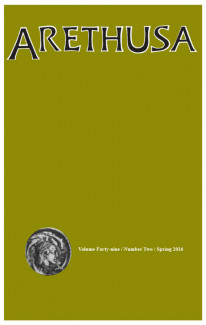
Johns Hopkins UniversityEst. 1876
America’s First Research University
Building a new image of Vitruvius

A conference at Yale University on marginality and canonicity inspired Marco Formisano and Serafina Cuomo to take a look at the work of ancient architect Vitruvius. That interest led to a recent special issue of the journal Arethusa on Vitruvius and his seminal work, de Architectura. Formisano and Cuomo guest edited the issue and joined us for a Q&A about their work.

Despite the rise of 'contact-less' forms of communication, conferences are still a fundamental part of our job, both as a means of disseminating research, and of generating new ideas. A lot, however, depends on the type of conference.
There are huge annual gatherings, with several parallel sessions, which are mostly for networking, getting a sense of where a certain field is going overall, and as a showcase for more junior scholars. Instead, the conference from which this volume originates was in the format of a workshop. Rather than issuing a general call for papers, we thought carefully about whom we wanted to invite, and how they might work together as a group. You could say that all our speakers were cherry-picked. Additionally, we deliberately invited some scholars who were not Vitruvius experts per se, because we thought they may add something new to the mix.
As a result, everybody really ended talking to everybody else, both formally and informally, and the participation to sessions was 100% engaged, with our authors bringing many different perspectives to one text. Getting a volume out of that was relatively easy, because there was already a sort of cross-pollination, but also a focus to the project.
How do you feel contributing to a growing field of study with this issue?
We think that this issue would not have been possible if the field of Vitruvius studies was not already relatively well-established. So in a sense we are building on foundations which are already there. What we are contributing is a combination of various approaches and disciplines, and also a combination of academic backgrounds, in the geographical sense. Modern Vitruvian studies took off on the so-called continent (continental Europe) decades before they did in the UK, USA and the rest of the English-speaking academic world. The volume includes contributions by French, Italian and German scholars, including - and we are very grateful for their participation - Elisa Romano and Pierre Gros, whose work has been seminal to modern Vitruvian studies. In this sense, we feel that one of the contributions of the issue is to integrate different strands of Vitruvian studies, and putting them in a dialogue with each other.
Do you feel fortunate to have been able to put together a diverse group of authors for the issue?
Yes, we certainly do! Some of those authors we knew already, in some cases for a very long time, but with a few of them it was a case of sending the invitation and keeping our fingers crossed that they'd find the project as exciting as we did.
How important is it for journals like Arethusa to provide a home like scholarship such as this?
We thought of Arethusa as a possible home for our project straight away, not just because of its reputation and rigour, but also because it is widely accessible online, and because it offers the opportunity to reproduce the integrity of a project, through the mechanism of special, monographic issues. Special issues are, we believe, the way to go - much preferable to conference proceedings of the more traditional kind - because they offer the infrastructure of peer reviewing and rigorous editing provided by a journal, together with the possibility to keep your project intact, plus they can be read by a wider audience.


